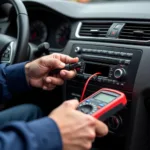Dealing with a leaking or worn-out rubber seal inside your car window? You’re not alone. This common issue can lead to water damage, annoying wind noise, and even compromise the structural integrity of your car’s interior. Fortunately, you don’t always need a mechanic to fix it. This guide will walk you through everything you need to know about repairing a rubber seal inside a car window, from identifying the problem to choosing the right solution.
Understanding Your Car Window Seal
Before diving into repairs, it’s important to understand what you’re dealing with. Your car window seal isn’t just one piece, but a system designed to keep the elements out and your car comfortable.
- Window run channel: This is the metal track that the window glass sits in. It guides the window’s movement up and down.
- Window sweep: Attached to the inside of the door panel, this long, vertical seal prevents debris and water from entering the door cavity.
- Beltline weatherstripping: Running along the top of the door frame, this seal prevents wind noise and water leaks when the window is rolled up.
- Inner and outer window scrapers: These seals are mounted to the door itself and make direct contact with the window glass, creating a tight seal to keep out water and wind.
Common Signs of a Damaged Car Window Seal
Knowing the signs of a damaged car window seal can save you from costly repairs down the line. Here’s what to watch out for:
- Water leaks: The most obvious sign – if you notice water pooling in your door or on the floor of your car after rain, you likely have a seal issue.
- Increased wind noise: A compromised seal can allow more wind noise into your cabin, especially at higher speeds.
- Visible damage: Inspect your seals for cracks, tears, or any signs of detachment from the door or window.
- Difficulty rolling windows up or down: A damaged seal can create friction, making it harder to operate your windows smoothly.
DIY Repair Options for Rubber Seals
Many car window seal repairs can be done at home with the right tools and a little patience. Here are some common methods:
1. Cleaning and Lubricating the Seal
Sometimes, a simple cleaning can work wonders. Dirt and debris can accumulate on the seal, preventing it from creating a tight seal.
- Clean the seal: Use a soft-bristled brush and a mild cleaning solution to gently scrub away any dirt or grime.
- Apply lubricant: Once clean and dry, apply a silicone-based lubricant specifically designed for rubber seals. This will help condition the rubber and improve its flexibility.
2. Repairing Minor Cracks and Tears
For small cracks or tears in the rubber seal, you can use a rubber sealant or adhesive:
- Clean the area: Thoroughly clean and dry the damaged area of the seal.
- Apply sealant: Apply a thin, even layer of rubber sealant or adhesive to the crack or tear, following the product instructions carefully.
- Let it dry: Allow the sealant to dry completely before operating the window.
3. Replacing the Seal
If the seal is severely damaged or beyond repair, replacement is the best option.
- Purchase a replacement seal: You can find replacement seals online or at your local auto parts store. Make sure to get the correct one for your car’s make and model.
- Remove the old seal: Carefully pry off the old seal, starting from one end. You may need a trim removal tool to avoid damaging the surrounding areas.
- Install the new seal: Clean the channel where the old seal was located. Starting at one end, gently press the new seal into place, ensuring it sits flush with the surrounding trim.
When to Consult a Professional
While DIY repairs can be effective for minor issues, some situations warrant professional attention:
- Extensive damage: If the seal is severely damaged or multiple seals are affected, it’s best to leave the repair to a professional.
- Window alignment problems: If the window isn’t sitting properly in the track or is difficult to operate, there may be an underlying issue with the window regulator or other components that require professional expertise.
how to repair car window rubber seal
Preventing Future Damage to Your Car Window Seals
Taking preventative measures can extend the life of your car window seals and save you from future headaches:
- Regular cleaning: Clean your car window seals regularly with a mild cleaning solution and a soft-bristled brush.
- Lubrication: Apply a silicone-based lubricant to your seals every few months, especially during extreme weather conditions.
- Avoid parking under trees: Tree sap and bird droppings can damage rubber seals over time.
- Address leaks promptly: Don’t ignore water leaks, even if they seem minor.
- Inspect your seals regularly: Make it a habit to inspect your car window seals for signs of damage every few months.
car window leak repair near me
Conclusion
Repairing a rubber seal inside a car window doesn’t have to be a daunting task. By understanding the different components involved, recognizing the signs of damage, and following the right repair techniques, you can often fix the problem yourself. However, for extensive damage or if you’re unsure about the repair process, it’s always best to consult with a qualified mechanic. By taking preventative measures and addressing issues promptly, you can keep your car’s interior dry, quiet, and protected for years to come.

